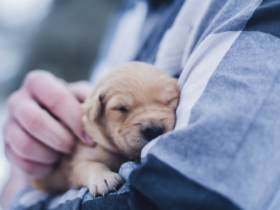While the annual Earth Day celebration on April 22 is a terrific reminder to show our planet some well-deserved love, every day is an opportunity for eco-friendly pet parents to make a difference with consistent sustainability habits.
Mary Ellen Kustin is a conservation and environmental health expert as well as a human mom of two and a pet mom to a sweet hound dog. She’s encouraged by the top-down changes in the pet industry to be more responsive to our desire for more thoughtfully produced products. “For example, pet toys, bedding, and clothing made of post-consumer materials are more mainstream options than they used to be,” she says. “And products made using rapidly renewable materials such as bamboo and wool are great, too.”
Every little eco-minded action we make as pet parents contributes to the greater good. In fact, it’s possible you’re already doing many essential things that are better for the planet than some alternatives on the market. This includes choosing sustainable products, creating a smaller footprint (er … pawprint) by purchasing supplies in bulk, or opting to adopt a rescue and follow best practices for spaying and neutering to prevent pet overpopulation. “Share your successful eco-friendly habit shifts on social media as well to plug into a wider community of people all doing what we can,” she says.
Kustin says that all this Earth love can actually come back to benefit pet parents in a very tangible way. It’s not just about feeling good about the purchases and choices you make because they’re better for the planet—they’re better for your wallet, too! “Often, truly ‘eco-friendly’ equates to ‘pocketbook-friendly,'” Kustin says. “When you buy fewer things, enjoy a little more DIY creativity, and buy what you do need in bulk, you’re saving money and doing good for the environment.” Right on!
Ready to save the planet (and some cash)? We’ve put together a list of a few other tips you can incorporate into your pets’ lives without a complete overhaul of your routine. And be sure to tag Daily Paws on social media using #DailyPawsPets if you share your eco-friendly good deeds with the rest of the world!
Eco-Friendly Practices and Products for You and Your Pets
1. Biodegradable Poo Disposal Options Are the Bomb
There’s often much debate among pet owners about what to do with kitty doo and dog poo. For example, Kustin answers that age-old question: if a pup poops in the woods and no one picks it up, is it still bad for the surrounding ecosystem? Yep!
“The excess nitrogen, phosphorus, and byproducts of pet food in dog poop detract from the health of natural areas,” she says. So if you can’t scoop, use biodegradable poop bags or, better yet, 100-percent biodegradable and compostable paper. And since cats really have no preference about what lines their boxes, ditch the clay litter. It often relies on strip mining to produce, and once used, takes up a lot of space in landfills. So it’s an easy switch to recycled paper, pine pellets, or wheat litter in your cat’s box instead.
If you’re really outdoorsy, consider making a pet waste compost pile. This has to be separate from regular compost, and there’s a particular process to follow to use it correctly, but you can still use the resulting humus as fertilizer for non-edible plant gardens.
2. Help Your Pup Wee Responsibly
You can ditch non-sustainable pee pads, too. Try washable options for senior pooches or dogs recovering from surgery. Puppies in potty training or small dogs needing extra help can do their business on pads that are plant-based or manufactured with upcycled diaper material.
3. If You Want Stuff, Be Picky and Buy Less of It
We totally get it: there are so many uber-cute subscription boxes for cats and dogs packed with oodles of nifty treats and toys, it’s a holiday for both you and your furry friend every time one arrives! But the fewer raw materials we use and less packaging we require, the better off we all are, Kustin says.
So wannabe green pet parents should be selective about what they purchase to cut down on packaging waste and unnecessary items. You might even try some funky sourcing through Freecycle. And when your pet is done gnawing on toys, or outgrows that adorable Halloween costume, pass it on to the next cat or dog with a fun swap party or “buy nothing” group.
Before you buy anything, consider researching with a tool like Finch that provides “actionable insights” into many popular products.
4. Host a Toy Exchange Party (After Sanitizing, Of Course!)
Do we need a reason to have a pet party? Never! But a toy exchange is a novel way to spruce your pet’s goodie box and have fun! Just be sure to keep Fido and his friends safe by getting everything squeaky clean first with some hot soapy water and a little elbow grease.
5. Plastics: Just Say No
The Environmental Protection Agency indicates that more than 69 percent of plastic containers and waste were landfilled in 2018. So while recycling helps, reduction is really a key component in limiting the amount of plastic that makes it into the trash (and the environment, for that matter). This doesn’t mean you shouldn’t continue to recycle PET and HDPE products, but you’ll likely have a greater green impact by choosing less of them in the first place.
6. Practice Mindful Lawn Care
You’ve probably already landscaped with plants, shrubs, and trees that are safe for your furry family members to sniff around. So also choose lawn care and gardening products with more natural ingredients. Many eco-forward companies such as Sunday and Espoma Organics are transparent about product contents so you can be assured they’re safe for pets and the environment.
7. Get Your Crafty On With Homemade Treats
Kustin says her kids love to help bake peanut butter treats shaped like a dog bone for their pooch. We can’t think of a better bonding activity for kids and critters than food, so slip on the aprons and give these pet treat recipes a try. You get to make a little magic together in the kitchen, and your pet gets a snack that’s made with less processing, shipping costs, and carbon emissions. It’s a win-win!
8. Keep Kitties Indoors and the Birdies Will Love You
It’s only natural for your cat to slink out and chase the smaller creatures in your neighborhood, but in order to protect the wild bird population (and your cat’s health, since roaming outdoors can put them at greater risk of parasites), it’s really best to keep Fluffy indoors. “Especially during late spring and early summer, make sure your cat is inside to keep them away from fledgling birds,” Kustin says.
She references facts from the American Bird Conservancy, which states “predation by domestic cats is the number-one direct, human-caused threat to birds in the United States and Canada. In the United States alone, outdoor cats kill approximately 2.4 billion birds every year. Although this number may seem unbelievable, it represents the combined impact of tens of millions of outdoor cats.”
But if your kitty chatters at the window and meows incessantly to go outdoors, Kustin recommends outfitting her with a bird-safe collar to stymy her ability to sneak up on birds. The bright colors, however unfashionable for a feline, help alert our winged friends to stay away.
You could also guide kitty through the natural world by training them to become an adventure cat! With a good harness and a little patience (okay, probably a lot), anything is possible.
9. Step In Line With No-Driving Walkies
Dog parks are a blast and good for socialization, but how far do you have to drive to get to one? To be more eco-minded, try to plan most pup outings in your neighborhood. This gets you both out the door more quickly and who knows? There might actually be some other two- and four-footed friends close by who want to join in the fun without driving.
10. Shop With Recycled/Reduced Packaging in Mind
While not a completely zero-waste option, this is another example of being eco-friendly on the front end to make a difference down the line. This includes shopping for products made with sustainable pet food packaging and even buying in bulk. Kustin adds that many pet cleaning supplies, for both messes and baths, also offer bulk refill bottles as a way to cut down on packaging materials.
11. Help Shelters and Rescues With Upcycled Goods
Any time you get something new for your furry friend, remember that shelters and rescue centers are always in need of blankets, beds, crates, towels, and gently loved stuffed animals and toys. Have a heartfelt convo with your pet about the benefits of giving away items they’re no longer using, wash everything well, and spread the joy.
12. Spiff Up Your Pet’s World With Sustainable Cleaning
Speaking of cleaning, your first instinct is to make sure anything you use around the house is safe for humans and pets. Added bonus? Saving big bucks. “Cheap, eco-friendly alternatives—like baking soda and vinegar—are far more pet-friendly chemicals to use in your home as well,” Kustin says. Be sure to consult with your vet before using these ingredients, however, because they can still be dangerous to pets if used improperly.
13. Repel Bugs More Naturally
Whether you’re romping in the backyard or chillin’ on the front porch of a cozy cabin, bugs will find you. If you need a repellant spray or patch, consider products that are DEET-free and, if made with essential oils, properly diluted and tested safe for pets. (Unfamiliar with essential oils? Review those potentially harmful for dogs and cats). Some people also burn cattail seed heads or dried sage as smoke-smudging options. Make sure Fido and Fluffy are up-to-date with all pest and parasite prevention health care, too.
14. Pep Up Your Pup With Veggie Options
While felines and canines are mostly carnivores, your pup can actually have more fruits and veggies in his daily diet (but consider these as only occasional treats for your cat). Less reliance on meat production has a significant environmental impact. As always, be sure to talk with your veterinarian about any dietary changes before swapping in new additions to your pet’s menu.
15. Entertain Your Cat With Creative DIY Toys and Homegrown Catnip
Kustin says one of the easiest eco-friendly cat toys is what her kids use with their aunt’s cat: they fashion fishing poles (no hooks, of course) with treasures they find in the backyard and cast away! Kitty goes crazy! A feather on a string. Hair ties. The ubiquitous box or paper bag. Even a square taped onto the floor. You really can keep playtime simple for cats, as their natural curiosity amuses them to no end. And growing catnip to add extra “enrichment” isn’t such a bad idea, either.
While not all these pointers fit with every lifestyle, remember: every little bit helps. “Whether you’re sunning by the window with your cat enjoying a breath of fresh air or hiking with your pooch on the sidewalk or in the woods, you and your furry love are growing your appreciation of our wonderful world together,” Kustin says. “Pets provide a marvelous reminder that we’re all part of this magnificent blue and green marble together.”




:max_bytes(150000):strip_icc()/eco-friendly-pet-parent-walking-dog-761609801-2000-a1bd6ea1778a486d840b02ca6c5a1ce6.jpg)
:max_bytes(150000):strip_icc()/new-kitten-checklist-309129797-2000-d1fa051cbab142ccb51e1be88d5a1e50.jpg)
:max_bytes(150000):strip_icc()/bedlington-terrier-lying-rug-1186353094-2000-0253d70f30a74f08a0b82354b0226d05.jpg)
:max_bytes(150000):strip_icc()/cat-shampoo-60faa26684d34026a9b482073b87d4c6.png)
:max_bytes(150000):strip_icc()/cat-trees-for-large-cats-2000-1ec2ca7fb1be49b78244096f5c2367b2.jpg)
:max_bytes(150000):strip_icc()/dog-proof-cat-feeder-2000-97b0ce6a5b65491282034cfb25b1033b.jpg)
:max_bytes(150000):strip_icc()/best-cat-puzzle-feeder-toys-2-2000-0f21a7daed5d423caf003d4bbdd02c28.jpg)
Leave a Reply
View Comments